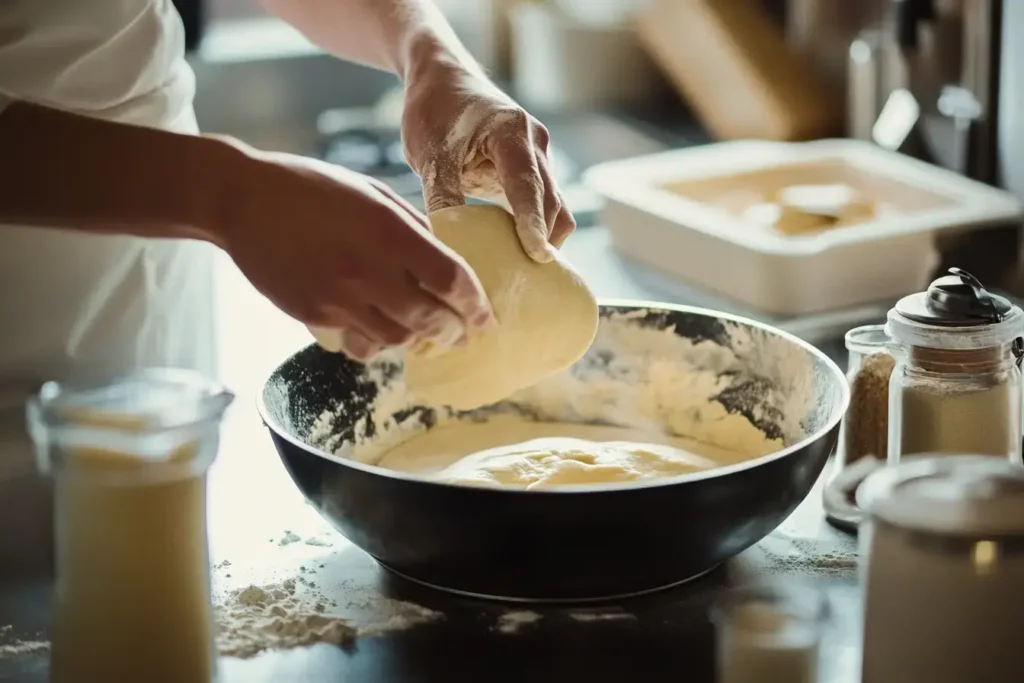If you’re searching for the perfect Gipfeli recipe, you’ve come to the right place! These buttery, flaky Swiss croissants are an absolute breakfast favorite. Whether you’ve tried them in Switzerland or are discovering them for the first time, this authentic Gipfeli recipe will help you bake perfect golden pastries right in your own kitchen.
Unlike traditional French croissants, Swiss Gipfeli have a slightly denser texture, making them unique and irresistibly delicious. Let’s dive into this step-by-step Gipfeli recipe, covering everything from ingredients to baking tips, common mistakes, and creative variations!
What Is a Gipfeli? Understanding the Swiss Croissant
A Gipfeli is Switzerland’s version of the croissant, but with a unique texture and flavor. While French croissants are extra flaky and airy, Swiss Gipfeli tend to be slightly denser and less greasy, making them perfect for both sweet and savory variations.
You’ll find Gipfeli in almost every Swiss bakery, often enjoyed with coffee or hot chocolate. But instead of waiting for a trip to Switzerland, why not try this homemade Gipfeli recipe today?
“A perfectly baked Gipfeli is golden, crispy on the outside, and soft and buttery on the inside.”
Ingredients You Need for an Authentic Gipfeli Recipe

To get started, gather these simple ingredients. A great Gipfeli recipe relies on high-quality ingredients to achieve that perfect flavor and texture.
Choosing the Right Flour for Flaky Gipfeli
For this Gipfeli recipe, it’s best to use bread flour instead of all-purpose flour. It has a higher protein content, which helps create a light, structured dough with better elasticity.
Butter vs. Margarine: What Works Best in a Gipfeli Recipe?
If you want authentic Swiss Gipfeli, always go for high-quality butter. Butter creates the rich, melt-in-your-mouth texture that makes homemade Gipfeli so irresistible.
Yeast or Sourdough: The Best Choice for a Light and Airy Texture
Traditional Gipfeli recipes use fresh yeast, but dry yeast works just as well. If you prefer a deeper flavor, you can try a sourdough Gipfeli recipe for a more complex taste.
Step-by-Step Guide: How to Make Gipfeli from Scratch

Now that you have your ingredients ready, it’s time to bring your Gipfeli to life! Follow this step-by-step guide to create light, flaky, and golden Gipfeli right in your own kitchen.
Preparing the Dough: The Key to a Fluffy Gipfeli Recipe
Follow this detailed Gipfeli recipe to achieve golden, bakery-style pastries at home.
Preparing the Dough: The Key to a Fluffy Gipfeli Recipe
- Activate the yeast – Mix warm milk, sugar, and yeast in a bowl. Let it sit for 10 minutes until foamy.
- Mix the dry ingredients – In a large bowl, combine flour and salt.
- Combine and knead – Add the yeast mixture and melted butter, mixing until a rough dough forms. Knead for about 10 minutes until smooth.
- Let it rise – Cover the dough and let it rest for about an hour until it doubles in size.
“Patience is key—if you rush the dough rising process, your Gipfeli won’t be as fluffy as they should be.”
Laminating the Dough: Creating Perfect Layers in Your Gipfeli Recipe
This is where the magic happens! Laminating means folding butter into the dough multiple times to create flaky layers.
- Roll out the dough – Once risen, roll the dough into a large rectangle on a floured surface.
- Add the butter – Place thin slices of cold butter over two-thirds of the dough.
- Fold and roll – Fold the uncovered third over the butter, then fold the remaining third over it (like folding a letter). Roll it out again into a rectangle.
- Chill and repeat – Wrap the dough in plastic wrap and refrigerate for 30 minutes. Then, repeat the folding and rolling process twice more for perfect layers.
This step is what gives Gipfeli that irresistible crispness on the outside and soft layers inside!
Shaping and Proofing: How to Get the Perfect Crescent Shape
Now comes the fun part—shaping your Gipfeli!
- Roll out the laminated dough into a large rectangle (about ¼-inch thick).
- Cut into triangles – Each triangle should be about 3 inches wide at the base and 6 inches long.
- Roll them up – Start from the wide base and gently roll the dough towards the tip, forming a crescent shape.
- Proofing time! Place them on a lined baking sheet, cover with a towel, and let them rise for another 30 minutes.
Baking Your Gipfeli Recipe: Temperature and Time for Perfection
To get that beautiful golden color and crispy texture, follow these baking tips:
- Preheat your oven to 375°F (190°C).
- Brush with egg wash (a mix of beaten egg and a splash of milk) for that shiny, golden crust.
- Bake for 15–20 minutes until deep golden brown and crisp on the outside.
When they come out of the oven, your kitchen will smell like a Swiss bakery!
Common Problems When Making a Gipfeli Recipe (And How to Fix Them)
Even experienced bakers run into trouble when making Gipfeli. If something goes wrong, don’t worry—I’ve got you covered with quick fixes for the most common issues.
Why Is My Gipfeli Dough Too Dry or Too Sticky?
If your dough feels too dry and crumbly, it’s likely that:
- You added too much flour—try reducing it slightly.
- The liquid wasn’t warm enough to activate the yeast properly.
If it’s too sticky and hard to handle, you may have:
- Used too much liquid—add a little more flour, one tablespoon at a time.
- Not kneaded it enough—kneading develops gluten, which helps form a proper structure.
How to Prevent Gipfeli from Becoming Too Dense
A good Gipfeli should be light and airy. If yours turn out heavy or dense, these might be the reasons:
- Not enough proofing time – If the dough doesn’t rise long enough, the yeast won’t do its job.
- Too much kneading – Over-kneading can make the dough tough instead of soft.
- Oven temperature too low – If your oven is too cold, Gipfeli won’t puff up properly.
Fix it: Make sure to proof your dough until doubled in size and bake at the right temperature.
Avoiding Butter Leakage: The Secret to a Flaky Texture
One of the biggest mistakes? Butter leaking out during baking! If this happens, your layers won’t be as flaky.
Why does it happen?
- The butter was too soft when laminating.
- The dough was overworked, making the layers weak.
- The oven wasn’t hot enough, causing the butter to melt before the dough sets.
How to fix it:
- Always use cold butter when folding it into the dough.
- Chill the dough between folds to keep the butter firm.
- Preheat the oven properly so the layers puff up before the butter melts out.
“Great Gipfeli is all about balance—too little butter and they’re dry, too much and they leak. Get it right, and you’re in pastry heaven!”
Variations of the Traditional Gipfeli Recipe
Why stick to just plain Gipfeli when you can try different flavors? Here are some fun variations to experiment with!
Chocolate-Filled Gipfeli: A Decadent Treat
Want a sweeter version? Add chocolate!
- Before rolling the dough, place a piece of dark chocolate at the base of each triangle.
- Roll it up, bake, and enjoy the melty chocolate center!
Want to take your sweet Gipfeli recipe to the next level? Instead of just using chocolate, try filling them with strawberry cream cheese for a fruity, creamy twist! It adds a delicious contrast to the flaky pastry, making it perfect for breakfast or dessert. Check out this Strawberry Cream Cheese Recipe for the perfect homemade filling!
Cheese and Smoked Salmon Gipfeli: A Savory Delight
If you prefer something savory, try adding cheese and smoked salmon before rolling them up.
- Use Gruyère or Emmental cheese for an authentic Swiss taste.
- Add thin slices of smoked salmon for a rich, savory flavor.
- Bake as usual, and enjoy a flaky, cheesy delight perfect for breakfast or lunch.
Other great savory fillings: Spinach and feta, mushrooms and cream cheese, or sun-dried tomatoes and mozzarella.
Storing and Reheating Gipfeli for Freshness
You’ve made perfect Gipfeli, but what if you have leftovers? Here’s how to keep them fresh.
The Best Way to Store Gipfeli Without Losing Crispiness
- Room temperature: Store in an airtight container for up to 2 days.
- Freezing: Wrap in plastic wrap and freeze for up to 2 months.
How to Reheat Gipfeli Without Drying Them Out
- Oven method (best option): Bake at 325°F (160°C) for 5 minutes to restore crispiness.
- Microwave (not ideal): 10–15 seconds, but they might turn soft instead of crispy.
Final Tips for Perfect Homemade Gipfeli Every Time
Here are some final takeaways to guarantee you make the best homemade Gipfeli:
✅ Use cold butter for perfect layers.
✅ Be patient with the dough—rushing proofing leads to dense pastries.
✅ Roll tightly but gently when shaping your Gipfeli.
✅ Bake at the right temperature for a golden, crispy crust.
✅ Experiment with flavors to find your favorite variation.
Now that you know all the secrets, it’s time to get baking! Try this recipe and enjoy your very own homemade Swiss Gipfeli.
Conclusion: Master the Perfect Gipfeli Recipe at Home
Making Gipfeli from scratch might seem like a challenge, but with the right technique, patience, and a little practice, you can create bakery-quality pastries right in your own kitchen. From perfecting the dough to nailing the flaky layers, every step adds to the magic of this iconic Swiss treat.
So, whether you enjoy them plain, filled with chocolate, or stuffed with cheese, your homemade Gipfeli will always be fresher and more satisfying than store-bought ones. Now, grab a cup of coffee, take a bite of your golden, buttery masterpiece, and enjoy the taste of Switzerland—straight from your oven!
Happy baking!
Frequently Asked Questions
Q1. What is the difference between Gipfeli and croissants?
Gipfeli and French croissants may look similar, but they have key differences! Gipfeli are less greasy, slightly denser, and have a firmer texture compared to croissants, which are more buttery and flaky. Swiss Gipfeli also tend to be mildly sweet or even savory, making them a versatile pastry.
Q2. Can I make Gipfeli dough in advance?
Yes! You can prepare the Gipfeli dough the night before and let it rest in the refrigerator overnight. This allows the flavors to develop and makes the rolling process easier. Just make sure to bring the dough to room temperature before shaping and baking.
Q3. Why is my Gipfeli not flaky enough?
If your Gipfeli is too dense and not flaky, a few things might have gone wrong:
- The butter may have been too soft during the lamination process.
- The dough wasn’t chilled properly between folds.
- You didn’t bake at a high enough temperature, which prevents proper puffing.
To fix this, always use cold butter, chill between folds, and bake at 375°F (190°C) for the best results!
Q4. Can I add fillings to my Gipfeli?
Absolutely! You can fill Gipfeli with sweet or savory ingredients before rolling them. Popular options include:
- Sweet fillings: Chocolate, jam, Strawberry Cream Cheese, Nutella
- Savory fillings: Cheese and spinach, smoked salmon, sun-dried tomatoes
Make sure not to overfill, or the layers won’t bake properly!

